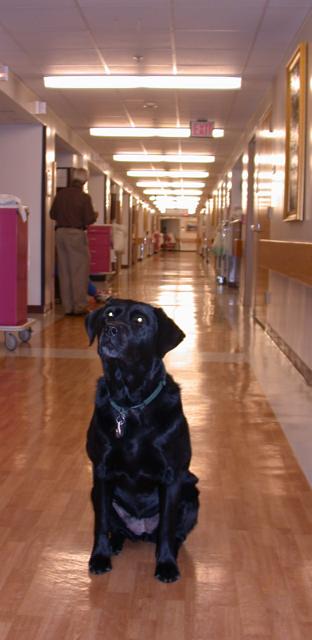Mention hospitals and people tend to think of tubes and bandages, wheelchairs and sterile, brightly lit hallways. For most of us, giggling, flirting and outright jumping for joy don’t come readily to mind.
But this isn’t an ordinary day in Mission Hospital’s Integrative Healthcare Department: Becky, an exuberant 7-year-old black Labrador, is on duty.
This morning’s agenda calls for proceeding to a secluded hallway for a rousing game of fetch. Mildred Ward, an elderly Nebo, N.C., resident needing to regain balance and strength after an extended hospital stay, glows in anticipation. An attendant with a wheelchair follows behind as Ward proudly shuffles down the hall with with her walker, leash in hand. (Therapy dogs always have two leashes on: one for the patient and one for the handler.)
Nurses turn to smile, first at Becky, then at Ward, whose delight is apparent. The arduous chore of daily exercise has been transformed: She’s moving in a bubble of joy that touches everyone in its path.
In a carpeted, dimly lit side hall, James R. Smith, who’ll share this therapy hour with Ward, waits in a wheelchair. The two will take turns throwing the ball while the other one rests. Between the patients, their therapists and attendants, Becky's handler, my escort and me, it makes for quite a party, with Becky as the star attraction.
Becky’s handler, Darlene Colmar, pulls a ball from her satchel; the dog cocks her head, perks her ears and comes to full attention. With assistance, Smith stands and takes the ball as Becky tracks the action.
“Throw it overhand as far as you can down the hallway,” the therapist instructs. Smith throws and Becky leaps, catching the ball in midair as a collective squeal of delight erupts and Becky takes a victory lap.
A major outing
Becky flunked her guide-dog exam years ago, but she’s found her true calling as a certified therapy dog. Colmar, a hard-working volunteer, not only participates with her own four dogs but also registers other teams (see “The Paw That Refreshes,” above).
To earn her registration, Becky had to pass a series of tests demonstrating basic obedience and confidence around hospital equipment. Any breed of dog can be used for therapy as long as the animal is loving, attuned to the handler and enjoys meeting new folks.
“Throw it higher, so she can't catch it,” says the therapist. Smith complies and Becky zigzags down the hall, ball bouncing off the walls.
One more throw and Smith is ready for a rest: It’s Ward’s turn. “Bend down and pick up the ball,” says her therapist. Not an easy task, but Ward meets the challenge.
“Now make a circle in the air with the ball,” prompts Colmar. Anticipating the move, however, Becky spins in a circle.
“How do you always guess what comes next?” wonders Colmar. “There are two things dogs live for: treats and balls,” she adds, producing a treat.
Laughing, Ward circles the ball in the air as Becky spins again.
More throws, more spins, more treats, some sits and downs, and it’s time to go back. The mood is quiet now; the patients are tired. This has been a major outing.
As we leave the hallway, Smith turns to Colmar and says, “I wouldn't be doing any of this if it weren't for Becky being here.”
“You aren't the first to say that,” she replies.
— Susan Hutchinson can be reached at shutchinson@mountainx.com.




Before you comment
The comments section is here to provide a platform for civil dialogue on the issues we face together as a local community. Xpress is committed to offering this platform for all voices, but when the tone of the discussion gets nasty or strays off topic, we believe many people choose not to participate. Xpress editors are determined to moderate comments to ensure a constructive interchange is maintained. All comments judged not to be in keeping with the spirit of civil discourse will be removed and repeat violators will be banned. See here for our terms of service. Thank you for being part of this effort to promote respectful discussion.